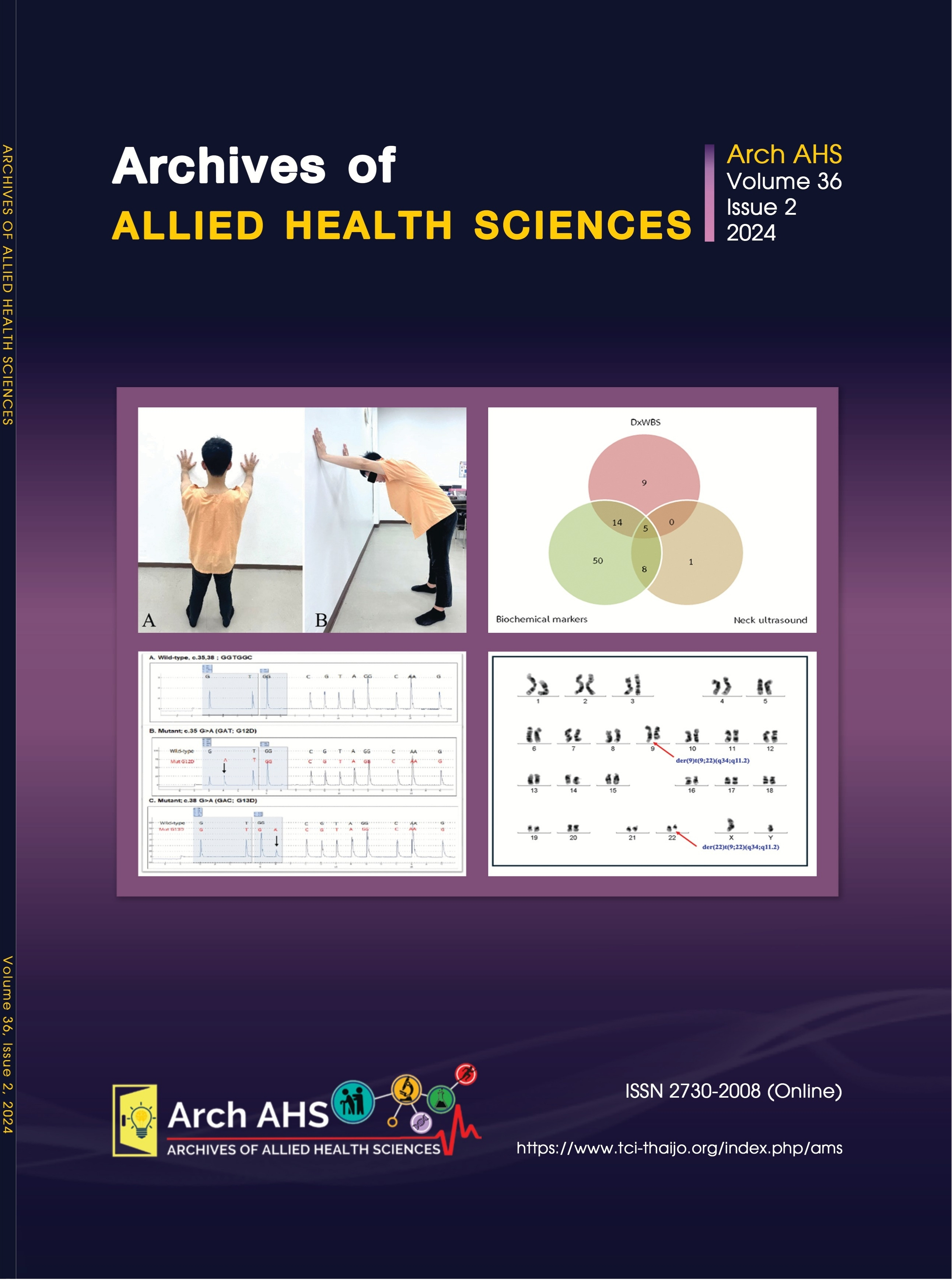Role of the 131I whole body scan for initial follow-up in patients with intermediate-risk differentiated thyroid cancer
Main Article Content
Abstract
A combination of diagnostic whole body scan (DxWBS), neck ultrasound, and serum stimulated thyroglobulin (stim-Tg) is now recommended for the initial follow-up in patients with intermediate-risk differentiated thyroid cancer (DTC). However, previous studies demonstrated the low additional value of DxWBS for the detection of persistent disease. This study aimed to determine the necessity of using DxWBS for the initial follow-up of these patients. This retrospective analytical study included 126 patients with intermediate-risk DTC (according to 2015 ATA guidelines) after total thyroidectomy and received the first 131I treatment. All patients underwent stim-Tg, neck ultrasound, and DxWBS at about 6–12 months after 131I treatment. Persistent disease was defined as uptake outside the thyroid bed from DxWBS, uptake within the thyroid bed from DxWBS, or an abnormal ultrasound finding with cytologically or pathologically proven persistent disease, positive for serum anti-thyroglobulin antibody (TgAb), or stim-Tg of 1 ng/mL or more. The percentage difference for detection of persistent disease when using only neck ultrasound with stim-Tg compared to a combination with DxWBS was calculated. We considered non-inferior when the percentage difference is below five. Of the 126 patients with intermediate-risk DTC, persistent diseases were detected in 85 patients and identified by DxWBS, neck ultrasound, and stim-Tg in 24, 14, and 77 patients, respectively. Combined neck ultrasound and stim-Tg could detect persistent disease in 78 patients. Although using only neck ultrasound and stim-Tg could detect 8.2% (95%CI: 1.2 to 15.3) of patients with persistent disease less than that compared with using combined all three modalities, all patients with only positive DxWBS showed thyroid remnants, not the true persistent disease. These findings indicated that DxWBS may not be necessary for initial follow-up in patients with intermediate-risk DTC.
Article Details

This work is licensed under a Creative Commons Attribution-NonCommercial-NoDerivatives 4.0 International License.
References
Dal Maso L, Tavilla A, Pacini F, Serraino D, van Dijk BAC, Chirlaque MD, et al. Survival of 86,690 patients with thyroid cancer: A population-based study in 29 European countries from EUROCARE-5. Eur J Cancer 2017; 77: 140–52.
Haugen BR, Alexander EK, Bible KC, Doherty GM, Mandel SJ, Nikiforov YE, et al. 2015 American Thyroid Association Management Guidelines for Adult Patients with Thyroid Nodules and Differentiated Thyroid Cancer: The American Thyroid Association Guidelines Task Force on Thyroid Nodules and Differentiated Thyroid Cancer. Thyroid 2016; 26(1): 1–33.
Cailleux AF, Baudin E, Travagli JP, Ricard M, Schlumberger M. Is diagnostic iodine-131 scanning useful after total thyroid ablation for differentiated thyroid cancer? J Clin Endocrinol Metab 2000; 85(1): 175–8.
Pacini F, Molinaro E, Castagna MG, Agate L, Elisei R, Ceccarelli C, et al. Recombinant human thyrotropin-stimulated serum thyroglobulin combined with neck ultrasonography has the highest sensitivity in monitoring differentiated thyroid carcinoma. J Clin Endocrinol Metab 2003; 88(8): 3668–73.
Rosario PW, Furtado MdS, Mineiro Filho AFC, Lacerda RX, Calsolari MR. Value of diagnostic radioiodine whole-body scanning after initial therapy in patients with differentiated thyroid cancer at intermediate and high risk for recurrence. Thyroid 2012; 22(11): 1165–9.
Lee JI, Chung YJ, Cho BY, Chong S, Seok JW, Park SJ. Postoperative-stimulated serum thyroglobulin measured at the time of 131I ablation is useful for the prediction of disease status in patients with differentiated thyroid carcinoma. Surgery 2013; 153(6): 828–35.
Jeon EJ, Jung ED. Diagnostic whole-body scan may not be necessary for intermediaterisk patients with differentiated thyroid cancer after low-dose (30 mCi) radioactive iodine ablation. Endocrinol Metab Seoul Korea 2014; 29(1): 33–9.
Moreno I, Hirsch D, Duskin-Bitan H, DickerCohen T, Shimon I, Robenshtok E. Response to therapy assessment in intermediate-risk thyroid cancer patients: Is thyroglobulin stimulation required? Thyroid 2020; 30(6): 863–70.
Park HJ, Jeong GC, Kwon SY, Min JJ, Bom HS, Park KS, et al. Stimulated serum thyroglobulin level at the time of first dose of radioactive iodine therapy is the most predictive factor for therapeutic failure in patients with papillary thyroid carcinoma. Nucl Med Mol Imaging 2014; 48(4): 255–61.
Watanabe K, Uchiyama M, Fukuda K. The outcome of 131I ablation therapy for intermediate and high-risk differentiated thyroid cancer using a strict definition of successful ablation. Jpn J Radiol 2017; 35(9): 505–10.
Verburg FA, de Keizer B, Lips CJ, Zelissen PM, de Klerk JM. Prognostic significance of successful ablation with radioiodine of differentiated thyroid cancer patients. Eur J Endocrinol 2005; 152(1): 33–7.
Connor RJ. Sample size for testing differences in proportions for the paired-sample design. Biometrics 1987; 43(1): 207–11.
Landis JR, Koch GG. The measurement of observer agreement for categorical data. Biometrics 1977; 33(1): 159–74.
Kim EY, Kim WG, Kim WB, Kim TY, Ryu JS, Gong G, et al. Clinical outcomes of persistent radioiodine uptake in the neck shown by diagnostic whole body scan in patients with differentiated thyroid carcinoma after initial surgery and remnant ablation. Clin Endocrinol (Oxf) 2010; 73(2): 257–63.
Grogan RH, Kaplan SP, Cao H, Weiss RE, DeGroot LJ, Simon CA, et al. A study of recurrence and death from papillary thyroid cancer with 27 years of median follow-up. Surgery 2013; 154(6): 1436–47.


